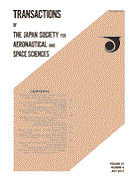All issues

Volume 61 (2018)
- Issue 6 Pages 231-
- Issue 5 Pages 181-
- Issue 4 Pages 143-
- Issue 3 Pages 99-
- Issue 2 Pages 51-
- Issue 1 Pages 1-
Volume 61, Issue 3
Displaying 1-5 of 5 articles from this issue
- |<
- <
- 1
- >
- >|
-
Ming XU, Ling JIANG, Xianghua JIA2018 Volume 61 Issue 3 Pages 99-105
Published: 2018
Released on J-STAGE: May 04, 2018
JOURNAL FREE ACCESSThe global coverage of a Sun-synchronous orbit is investigated in this paper to provide reasonable references for the orbit design of remote-sensing satellites. Firstly, the connection between revisiting and repeat ground-tracking is bridged applying the concept of Q value. Starting from the Q-value-determined base interval, a mathematical expression is derived for the accessing sequence of the nodes. Then, the coverage percentage is acquired by mixing the accessing sequence and coverage area, which depends on the orbital altitude and observation angle. Finally, the coverage of a satellite in a Sun-synchronous orbit is illustrated from three aspects: time-varying coverage percentage, minimal coverage time and minimal observation angle required by global coverage. Validation of the existing satellites' parameters shows that the method proposed in this paper is simple but effective, and these coverage analyses will contribute to shortening the time to design an optimal Sun-synchronous orbit for remote-sensing satellites.View full abstractDownload PDF (2465K) -
Takeshi KANDA, Masaki SATO, Toshiya KIMURA, Hiroya ASAKAWA2018 Volume 61 Issue 3 Pages 106-118
Published: 2018
Released on J-STAGE: May 04, 2018
JOURNAL FREE ACCESSThis paper describes the characteristics of methane-fueled rocket engines and compares these characteristics with those of hydrogen-fueled engines in terms of both expander and coolant-bleed cycles. Methane vaporizes in a cooling jacket under low-pressure operating conditions, whereas it liquefies in the turbine in the coolant-bleed cycle. The thermodynamic property of methane limits the operating range of methane-fueled engines. When the coolant-bleed cycle is used, the specific impulse degradation of methane-fueled engines becomes larger compared to that of hydrogen-fueled engines. This is due to methane having a lower specific heat and temperature after regenerative cooling. Even though the heat absorbing ability of methane is much lower than that of hydrogen, methane-fueled engines can operate with higher chamber pressures using the expander cycle. This is due to the larger density and the higher temperature after the regenerative cooling of liquid methane. Throttling of the methane-fueled engines does not have a great impact on the pump exit pressure in the expander cycle, whereas it increases the bleed ratio and degrades the specific impulse in the coolant bleed cycle of methane-fueled engines.View full abstractDownload PDF (1381K) -
Yuki TAKAO, Toshihiro CHUJO, Osamu MORI, Jun’ichiro KAWAGUCHI2018 Volume 61 Issue 3 Pages 119-131
Published: 2018
Released on J-STAGE: May 04, 2018
JOURNAL FREE ACCESSSpinning-type membrane space structures easily deform because they have no supporting structure. This may lead to an unexpected change in the effect of solar radiation pressure (SRP) on the membranes. Since SRP is a dominant factor of the dynamics of membrane space structures, especially for solar sails, knowledge of deformation is vital. However, it is almost impossible to precisely predict and design the actual deformation of membranes. This study provides a method to actively control the deformation of spinning membrane space structures. A completely fuel-free solar sailing technique is also shown as one application of the shape-control method developed.View full abstractDownload PDF (6662K) -
Rei YAMASHITA, Kojiro SUZUKI2018 Volume 61 Issue 3 Pages 132-140
Published: 2018
Released on J-STAGE: May 04, 2018
JOURNAL FREE ACCESSThis paper investigates the applicability of direct simulation considering a stratified atmosphere to an unsteady analysis of a blast wave caused by a meteorite explosion. Axi-symmetric Euler equations with a gravity term that considers a horizontally stratified atmosphere are numerically solved to analyze blast wave propagation from the source of meteorite explosion to the ground. Computations are made to reproduce the blast wave generated by the Chelyabinsk meteorite in 2013, assuming a spherically uniform high-pressure and high-temperature core as the source of explosion. The amount of energy released by the explosion at an altitude of 25 km is assumed to be 500 kt of trinitrotoluene, and the computational domain ranges over a radial distance of 50 km from the center of the explosion. The simulation results in a uniform atmosphere agree well with the results of well-known Brode’s empirical formula, and the blast wave obtained from the simulation considering a standard atmosphere is expected to cause serious damage to the ground, as experienced at the time of the Chelyabinsk event. Moreover, the simulation results clarify the characteristics of blast wave propagation through uniform, isothermal, and standard atmospheres.View full abstractDownload PDF (2625K)
-
2018 Volume 61 Issue 3 Pages 141
Published: 2018
Released on J-STAGE: May 04, 2018
JOURNAL FREE ACCESSDownload PDF (29K)
- |<
- <
- 1
- >
- >|